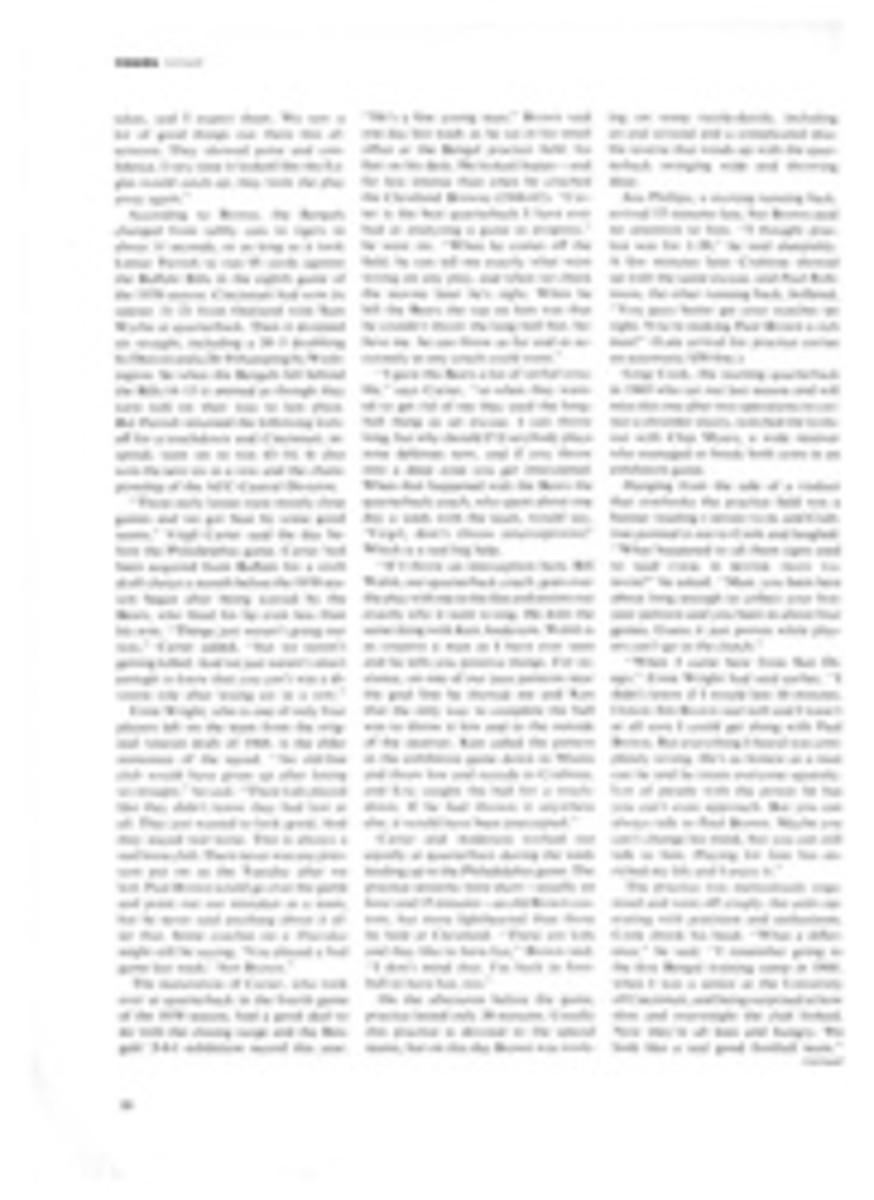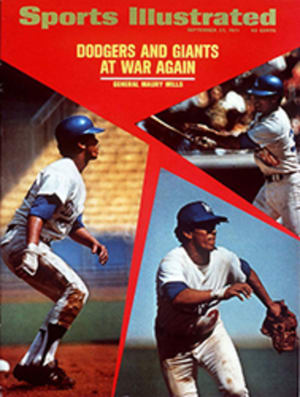
A CHEERLEADER COULD RUN THE TEAM
It frequently happens in a football game involving Notre Dame that all anyone can see after a while are these clusters of golden helmets, bouncing and swooping about, feasting on something indistinguishable. Like, for example, an opponent. Suddenly, shock waves seem to be leaping from the helmets to the Golden Dome itself, then up to Heaven, and then down to the scoreboard, and a cold truth becomes plain to everyone. The Fighting Irish are playing the game all by themselves.
Through the years Notre Dame has probably played more football games against itself than any other college team. And not just in the old days against all of those Ohio Northerns and Almas and Haskells. Nowadays the Irish have Navys and Pittsburghs and Northwesterns mixed in with their more physical enemies. These games aren't really scheduled as shakedown cruises, of course, but that is what they have become since Ara Parseghian brought Notre Dame back to the glory it relished under Knute Rockne and. Frank Leahy.
Notre Dame loses opening games only about as often as it has an Elmer Layden or a Terry Brennan or a Hugh Devore for a coach. Rockne never lost one. Neither did Leahy. And neither has Ara, who began his eighth season last Saturday in South Bend in the same old predictable way—with a laugher.
Actually, last week's game against Northwestern was possibly Notre Dame's toughest opener since Purdue in 1966, a day when Ara unveiled Terry Hanratty and Jim Seymour and started prowling for a national championship, which he got. Northwestern had played a pretty good game against Michigan the week before and was still considered a Big Ten contender. And it was known that Notre Dame did not have a Terry Hanratty or Joe Theismann or even a John Huarte around. A lot of beef, yes. But no one to drive the herd.
What happened, naturally, as it usually does when a have faces a have-not, is that one of those cute cheerleaders from St. Mary's could have played quarterback against Northwestern. And if she had, grinding, muscular, deep and resourceful Notre Dame might still have won by the same score: 50-7.
It was a football game for only 15 minutes, and only then because Northwestern had managed to drive for a touchdown with such tools as a fake punt and a pass-interference penalty. Thereafter, the imposing Notre Dame defense took over and the only remaining suspense was which of the golden helmets would intercept the most passes, or which ponderous Notre Dame lineman would mortally wound Northwestern's Quarterback Maurie Daigneau before he could release the ball.
It turned out that the Irish secondary stole seven passes and returned them for a total of 185 yards and two touchdowns, not to mention the scores that these thefts set up. Notre Dame stole everything but the apostrophe that might once have been in Daigneau's name.
Notre Dame might have swiped even more passes if such nimble thieves as Ken Schlezes, Mike Crotty, Clarence Ellis and Ralph Stepaniak had not kept bumping into each other going for the ball. As it was, Schlezes wound up with three and Crotty with two, including a 65-yarder for a touchdown.
All in all, the senior-flavored Notre Dame defense gave the junior flavored Notre Dame offense the benefit of such continually splendid field position—roughly, the Northwestern 40-yard line—that the question of who the Irish quarterback should be, or could be, or will be, or ought to be, was impossible to determine.
"I still don't know," said Ara Parseghian later. "We might have two or three all year."
The cast, in order of its appearance, was Pat Steenberge, a junior who started the game and tried the most passes, hitting one to Tom Gatewood for a touchdown; Bill Etter, a good runner and a junior in eligibility who sat out last year because of persistent headaches; and Cliff Brown, a gifted black athlete who suffered some obvious sophomore jitters.
Most likely, it will be a two-man battle for a while between Steenberge and Etter. Last week Ara hustled them in and out regularly before turning the fourth quarter entirely over to Brown, who is possibly the best athlete of the three. There is little or no difference between Steenberge and Etter. Both can run some and throw some, but neither as well as Theismann, which is no alarming headline, of course. Perhaps it isn't even an alarming problem.
The rushing game looks awesome out of Ara's own form of the wishbone T, and there are more good Notre Dame runners in evidence than Ara has ever had. He appears to be able to work a shuttle system with such backs as Ed Gulyas, Bill Gallagher, Andy Huff, John Cieszkowski, Greg Hill, Bob Minnix and Larry Parker with so much ease and confidence that there will always be fresh power.
It might not matter whether Steenberge or Etter is the fellow handing off, for Ara himself seems determined to call most of the plays. Which quarterback takes over, then, will depend on which one turns out to be the best passer, the best "reader" for audibles, the best reader of the triple option and perhaps the best leader.
Last Saturday Ara felt Steenberge understood the total "concept" of the Notre Dame attack slightly better than Etter, but he also felt Etter ran better than Steenberge and provided the big plays that got the victory under way Ara called them even.
It was Etter who went in after big Walt Patulski had blocked a punt and given Notre Dame the ball on Northwestern's 32-yard line, and he promptly moved the team to the goal line. Etter ran for 26 of those 32 yards before Ara sent Steenberge in to make the handoff to Gulyas for the first touchdown.
Again, it was Etter who hit the big pass—a 32-yarder to Gallagher—in the second touchdown drive, the only real drive the offense was asked to make. But it was Steenberge who came in to make the handoff to Minnix for the touchdown. And it was Steenberge who passed to Gatewood for the third touchdown that ended a 41-yard march and got Notre Dame securely out in front by 21-7.
After the game Steenberge said, "Naturally, I'd like to be the quarterback and play the whole game, but if we can do it this way and win every week, then that's all that matters."
And Bill Etter, the onetime school heavyweight boxing champ and surely the first Notre Dame quarterback with a mustache since 1887, said, "I'd like to be top dog, just like Pat, but we helped each other out there. Sort of complemented each other."
Tom Gatewood, the All-America end who caught Theismann for two years, did not know any more about the situation than he did before Northwestern came to town. And he would not reveal a quarterback preference.
"Anything we do will be a surprise every week," said Gatewood. "But I don't think of it as a problem for us. I like to think that we just have some quarterback depth."
The one thing that was revealed by the performances of both Steenberge and Etter is that both of them are a long way from the type of quarterback that Parseghian and Notre Dame are accustomed to. Neither looks like a potential Heisman Trophy winner, or an All-America. They aren't even wearing the magic numbers, like the No. 7 that Theismann and Huarte wore, or the No. 5 that Hanratty and Paul Hornung wore, or the No. 3 that Ralph Guglielmi and Daryle Lamonica wore. Not even a No. 9 for Bob Williams, or a No. 10 for Angelo Bertelli. And certainly not the old-fashioned No. 32 for Johnny Lujack. Steenberge is No. 11, of all things, and Etter is No. 2. But maybe this doesn't matter. This year it looks like the important Notre Dame numbers are being worn by the defense and the runners.
Besides, how can it matter if Notre Dame is only going to play itself most Saturdays?
PHOTO
Bill Etter (2) contributed some crucial plays that helped turn a close game into a laugher.
PHOTO
Pat Steenberge threw the lone scoring pass.

